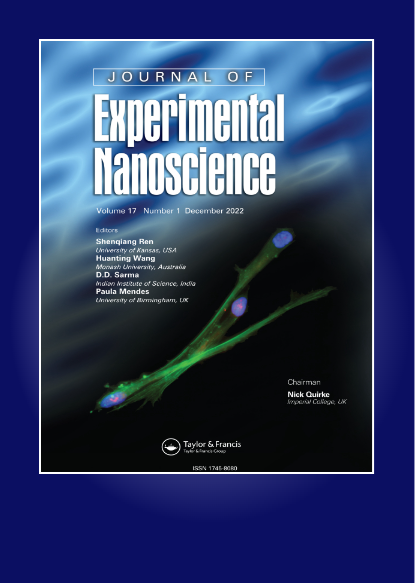燃料-氧化剂比、氢电位和退火温度对水热法制备纳米晶MgO粉体结构和光学性能的影响
IF 2.8
4区 材料科学
Q2 CHEMISTRY, MULTIDISCIPLINARY
引用次数: 0
摘要
采用水热法制备了纳米氧化镁粉体。在不同的燃料-氧化剂比(F/O)和pH值为8 ~ 12的前驱体溶液中,以六水硝酸镁Mg(NO3)2为氧化剂,聚乙烯醇(PVA)为燃料。为了提高结晶度和相纯度,这些材料在不同温度下退火两小时。采用XRD、FTIR、EDS、FESEM和DRS对MgO纳米粉体的结构、振动、元素和光学性质进行了研究。燃料-氧化剂比、退火温度和pH值对样品的性能影响较大。合成的粉体粒径分布在18 ~ 49 nm之间。XRD结果表明,随着F/O从0.5增加到0.75,MgO相的结晶率逐渐增大,当F/O = 1时,MgO相的结晶率逐渐减小。pH = 8时结晶率最高。随着退火温度的升高,样品的晶粒尺寸从22.82 nm增大到49.06 nm,比表面积和位错密度分别从20.59 m2/g和0.0006 nm - 2减小到7.83 m2/g和0.0001 nm - 2。FTIR光谱结果表明,在pH = 8时,MgO在(418 ~ 688 cm−1)处的峰值较高,在pH = 10时峰值减小,在pH = 12时峰值最小。通过EDS测量进一步证实了MgO的存在及其在最终产品中的均匀性。DRS光谱利用Kubelka-Munk关系得到了MgO NPs在5.72 ~ 5.89 eV范围内的能隙。本文章由计算机程序翻译,如有差异,请以英文原文为准。
Influence of fuel-to-oxidizer ratio, potential of hydrogen and annealing temperature on the structural and optical properties of nanocrystalline MgO powders synthesized by the hydrothermal method
Nanocrystalline magnesium oxide powders (MgO) were prepared using a hydrothermal method. In various fuel-to-oxidizer ratios (F/O) and precursor solutions with pH levels from 8 to 12, magnesium nitrate hexahydrate Mg(NO3)2 was utilized as an oxidizer and polyvinyl alcohol (PVA) as a fuel. To improve crystallinity and phase purity, these materials were annealed for two hours at varied temperatures. XRD, FTIR, EDS, FESEM and DRS were used to study the MgO nanopowders’ structure, vibration, elemental and optical properties. The fuel-to-oxidizer ratios, annealing temperatures and pH values greatly affected the samples’ properties. The synthesized powders had a particle size distribution in the range of 18–49 nm. The XRD results showed that the crystallite percent of the MgO phase grew with an increase in the F/O from 0.5 to 0.75, and then, it decreased at F/O = 1. The maximum percent of crystallites was observed at pH = 8. By increasing the annealing temperatures, the crystallite size of the samples increased from 22.82 nm to 49.06 nm, while the specific surface area and dislocation density decreased from 20.59 m2/g to 7.83 m2/g and 0.0006 nm−2 to 0.0001 nm−2, respectively. FTIR spectra results indicated that the MgO band peaking at (418–688 cm−1) was high at pH value 8, then it reduced at pH 10 and finally, this peak had the smallest size at pH = 12. Further confirmation of MgO presence and its homogeneity in the final product was approved through EDS measurements. DRS spectra were used to obtain energy gap using Kubelka–Munk relation and noticed in the range of 5.72–5.89 eV for MgO NPs.
求助全文
通过发布文献求助,成功后即可免费获取论文全文。
去求助
来源期刊

Journal of Experimental Nanoscience
工程技术-材料科学:综合
CiteScore
4.10
自引率
25.00%
发文量
39
审稿时长
6.5 months
期刊介绍:
Journal of Experimental Nanoscience, an international and multidisciplinary journal, provides a showcase for advances in the experimental sciences underlying nanotechnology and nanomaterials.
The journal exists to bring together the most significant papers making original contributions to nanoscience in a range of fields including biology and biochemistry, physics, chemistry, chemical, electrical and mechanical engineering, materials, pharmaceuticals and medicine. The aim is to provide a forum in which cross fertilization between application areas, methodologies, disciplines, as well as academic and industrial researchers can take place and new developments can be encouraged.
 求助内容:
求助内容: 应助结果提醒方式:
应助结果提醒方式:


